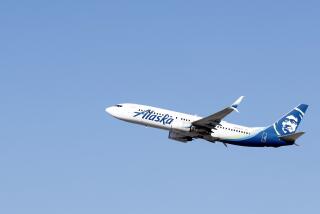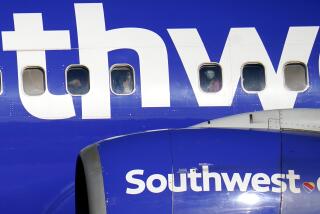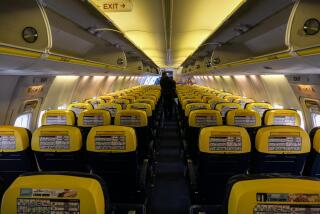Studying Medical Kits
- Share via
The Federal Aviation Administration is about to evaluate reports from airlines on the upgraded medical kits they were required to have on planes carrying 30 or more passengers.
Airlines were ordered to report all medical emergencies for two years, describing how the medical kit was used, by whom and the outcome of the emergency.
The evaluation will be used to determine whether any modifications are needed in the kit.
Unfortunately, the findings from the first year were not usable, an FAA spokeswoman said.
“Some reports were handwritten, others were computer printouts and some didn’t provide sufficient specifics,” she said.
“Information given was incomplete and inconsistent, and there was a lack of uniformity, which makes it hard to draw conclusions.”
Not reporting the new findings according to the rules could result in action against the airlines.
No Change Ordered
No directive to produce greater uniformity and specificity in these reports was sent to airlines.
“The reporting requirements for the airlines were established through a regulatory process, and we couldn’t make changes in the reporting procedure midstream without new regulations,” the spokeswoman said.
As a result, reports in the second year also may prove valueless.
The first year (Aug. 1, 1986, to July 31, 1987) indicated that the kits were used mostly by doctors. There were only four instances of use by flight attendants, according to the FAA.
“Eight deaths were reported. But passengers who died en route to hospitals, but not on planes, were not listed,” the spokeswoman said.
For Professionals Only
When the new kits were introduced, airlines indicated that they would familiarize their staffs with the equipment, but only physicians and health professionals could have access to them. This is still the case.
For example, a Delta Air Lines spokesman said: “Our policy is that crews are not to open these kits, which are only for qualified medical personnel. We prefer licensed doctors, but there are exceptions where the captain of the plane can use his judgment to let someone else like a registered nurse use the kit, if he feels the person is capable.”
Among the items in the medical kits are a blood pressure cuff, a stethoscope, nitroglycerin, Adrenalin, an instrument to clear the air passage and syringes and needles.
But these expanded kits, containing equipment and prescription drugs for treating such emergencies as heart attacks, insulin shock and acute allergic reactions, still fell short.
Originally proposed, but left out, were such items as scalpels and surgical items, as well as morphine and various other drugs and controlled substances.
Issue of Liability
Drug security was a prime factor in their deletion. Some of the drugs, however, are carried by foreign aircraft in their medical kits.
The issue of liability in the use of these kits is still unresolved. The FAA has argued that it is a subject for Congress to handle and that it’s up to the carriers who use the kits. Various “good Samaritan” bills have been proposed to ease the fear of liability of doctors who go to the aid of passengers.
A bill before the House of Representatives would give doctors protection against malpractice suits.
“Statistics indicate that nine out of 10 doctors provide assistance without the benefit of such liability protection, and that there are doctors on 75% of all long-distance flights,” said Con Hitchcock, legal director of the Aviation Consumer Action Project.
‘People Aren’t Dying’
“I haven’t heard of any malpractice suits. People aren’t dying, and the system seems to be working. This bill seems to be a solution in search of a problem.”
Nonetheless, Hitchcock said that his organization is waiting to see what the FAA learns from the airlines.
“We want to learn what conditions or situations occurred that couldn’t be treated, to see if the kits can be improved.”
Said Matt Finucane, safety coordinator of the Assn. of Flight Attendants, which has lobbied Congress for passage of a good Samaritan bill: “We’re still in favor of giving doctors protection against liability for treating passengers on flights. Even if there are only a few physicians who don’t offer to help, passengers having a heart attack or other problems would like to know that any doctor on their flight wouldn’t hesitate to come to their aid.”
Meanwhile, the air you breathe on planes may change, depending on the results of an FAA study, expected to be ready for Congress by April, 1990.
Aircraft air improved considerably with the smoking ban on domestic flights of two hours or less. But that rule, which ends in April, 1990, was only for two years.
Ironically, there is concern that the no-smoking rule may create a situation that would result in unhealthy cabin air. Some critics argue that the rule may prompt pilots to reduce ventilation in a plane to save fuel.
Other Pollutants
The FAA study also will determine whether aircraft air carries pollen, bacteria and hydrocarbons. Some studies indicate that aircraft ventilation systems can spread illnesses such as the flu.
The FAA mandates that plane cabins be suitably ventilated, “But this rule can be subject to interpretation,” an FAA spokesman said. “So this study will be the foundation for any new rules.”
The FAA’s Air Worthiness Standards restrict levels of ozone, carbon dioxide and carbon monoxide in cabin air. Pinpointing levels of smoke and other contaminants may lead to expansion of the regulations and more specific rules.
More to Read
Inside the business of entertainment
The Wide Shot brings you news, analysis and insights on everything from streaming wars to production — and what it all means for the future.
You may occasionally receive promotional content from the Los Angeles Times.










